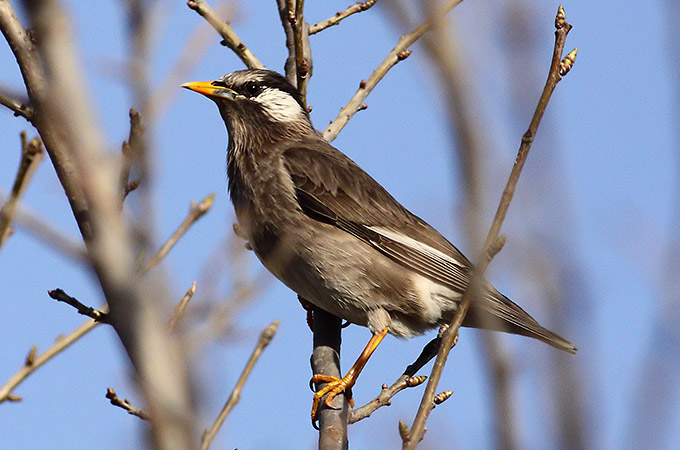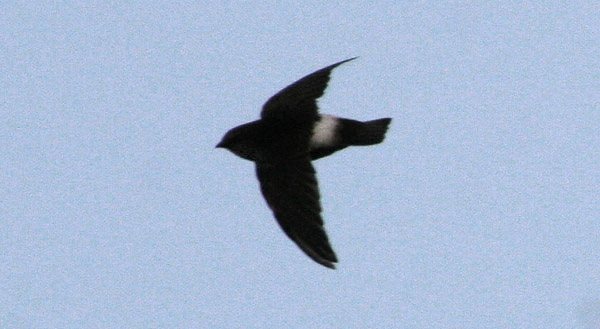
Daurian Redstart
Image Credit: Nomadic Journeys
I spent the past week or so touring some historical sites in China. As always, I bought my binoculars in case I should happen to stumble upon any interesting birds. Overall, birding was pretty slow on the mainland. Other than Eurasian House Sparrows, Common Swifts and Spotted Doves, there were not many birds one could see regularly.
Beijing

White-cheeked Starling
Image Credit: Tim Edelstein
The first stop on the trip was Beijing. Due to some unplanned flight delays, we did not arrive in Beijing until after midnight. The following morning, I did a little birding around the hotel. By far the most abundant birds were Eurasian Tree Sparrows. There were also a fair number of magpies, both Black-billed and Azure-winged. In the sculpted gardens around the hotel, I found a few White-cheeked Starlings. A few Large-billed Crows were heard calling. Back in our hotel room, I had a pretty decent view of the city and the scores of Common Swifts circling overhead.
We next visited the Temple of Heaven. There was a nice park on the temple grounds which housed lots of Eurasian Tree Sparrows and Spotted Doves. I did find one sweet spot in the park with a nice variety of birds. In addition to the two magpies mentioned above, I also spotted a pair of Red-billed Blue Magpies. They are quite striking birds. Blue birds, with black heads accented by a brushed white crown and nape, and a large red bill. They are about crow-sized with long flowing tails. I also pulled in a few lifers here as well, such as the Great Spotted Woodpecker, Gray-faced Woodpecker, Yellow-billed Grosbeak and Oriental Greenfinch.

Gray-faced Woodpecker
Image Credit: Cosmin-Ovidiu Manci
The Summer Palace was next on the agenda. The park has what appears to be excellent habitat for birds. Lots of tree and shrub cover, hills, and ample access to water. That being said, the place was virtually devoid of birds except for a few Black-crowned Night Herons patrolling the lake. And of course the Eurasian Tree Sparrows.

Chinese Hill Warbler
Image Credit: Bob Thompson
Our final Beijing destination was the Great Wall at Badaling. The wall itself was incredible, and quite a challanging climb in spots. I did manage to take a peak over the edge of the wall numerous times looking for birds. Suprisingly, few birds were observed other than Azure-winged Magpies and more Tree Sparrows. At one spot near the Hero's Slope, my daughter spotted what turned out to be a female Daurian Redstart carrying nesting material. I watched the bird for about 10 minutes and also found the male. They were apparently nesting in one of the towers. While watching the redstarts, I also managed to find a Great Tit as well as a Chinese Hill Warbler. The warbler was quite striking with its long tail, and heavily streaked head and back. Down at the base of the wall, I got a really good look at a singing Red-gorgeted Flycatcher perched on a wire above a concession stand. I was quite surprised to see the bird here, as it is a bit north of its range (as reported by MacKinnon and Philips in "Birds of China").
Xi'an

Brown-breasted Bulbul
Image Credit: Michael19481
Xi'an is in north central China, just north of the Qinling moutains. The area is basically a flood plain for the Wei River. As such, the area was pretty flat overall. Birding here was not much better than the Beijing area. Again, Eurasian Tree Sparrows were the predominate species. The area around the hotel was pretty quiet. There were several Red-rumped Swallows circling above the hotel and a few Eurasian Blackbirds in the hotel gardens. The highlight was a Eurasian Sparrowhawk that strafed the trees. That was about it.

Scarlet Minivet
Image Credit: Vijay Cavale
Our first destination was the Terra Cotta warriors site. The birds here were pretty sparse. Species of note included lots of Light-vented Bulbuls and Oriental Greenfinch. Also saw one Brown Shrike hunting insects and a Black Drongo perched on a wire. Later, we headed to the Huaqing Hotsprings to visit the site where Chiang Kai-shek was held captive during the Chinese Civil War. There were a nice mix of birds in that area, such as a pair of Great Tits foraging with two fledglings. I also observed an immature male Scarlet Minivet singing from a perch atop the bathing area for the emperor's favorite concubine. Light-vented Bulbuls were fairly abundant. I also managed to find two other bulbul species, a Collared Fincnbill and a Brown-breasted Bulbul.
Fuzhou
Our next destination was Taiwan. In order to get a direct flight to Kaohsiung, we had to fly through Fuzhou and spend the night. I didn't have the opportunity for much birding here, but did manage to see a few things along the way to/from the airport as well as in a local park and garden near our hotel. Near the airport, I saw several Cattle Egret and a lone Ring-necked Pheasant foraging in a field. Overhead, a Black-crowned Night Heron and a few Little Egret was passing by. Near the hotel, there were lots of House Swifts circling.

House Swift
Image Credit: Charlie Moores
Summary
Overall, I observed 33 species of birds over the past week. Of these, 18 were firsts for my China list, including 11 birds on my world life list.
Commentary on the Scarcity of Chinese Birds
I am not exactly sure whey there are so few birds in China. One obvious answer is that this impression is incorrect. I did a a fair amount of birding in urban areas. As expected, there would be less birds here than one would expect in the countryside or in forested areas.
Other evidence suggests that the impression is correct. I did a fair amount of birding in some forested and agricultural areas. Even there, the number of birds seemed to be less than I would have encountered in similar areas in the US. It is possible that I was just there at the wrong time or some similar reason. However, in talking with others who have birded in China, they have the same impression.
Some of the locals tell me it is a carry-over from Cultural Revolution policies. Apparently, Mao instructed people to kill birds because birds ate seeds (and thus food). I guess no one told him that birds also eat insects, which in turn eat plants, which results in even less seeds... I think you get the point. Others I have spoken to suggest that agricultural practices in China are having a large negative impact on birds. I have read several articles that support this view as well. Either way, in my experience, bird diversity was low throughout China.


